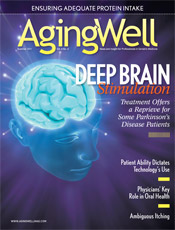
Summer 2011
Medication-Related Problems in Geriatric PharmacologyBy Brian Wolstenholme, PharmD, CGP, FASCP While elders make up less than 13% of the U.S. population, they consume 34% of all prescription medications. With the aging of the baby boomer generation, this number will increase dramatically over the next 30 years, necessitating a larger focus on geriatric medication issues and an increase in geriatric-competent clinicians to ensure optimal care. Identifying, preventing, and resolving medication-related problems (MRPs) will become increasingly important to the stability of our healthcare system and economy as this cohort grows in size and proportion in the coming years. An MRP, as defined by Hepler and Strand, is “an event or situation involving drug therapy that actually and potentially interferes with optimum outcome for a specific patient.” MRPs can be broken down into the following eight categories: 1. Untreated conditions: The patient has a medical condition that requires drug therapy but is not receiving a drug for that condition. 2. Drug use without indication: The patient is taking a medication for no medically valid condition or reason. 3. Improper drug selection: The patient’s medical condition is being treated with the wrong drug or a drug that is not the most appropriate for the patient’s special needs. 4. Subtherapeutic dosage: The patient has a medical problem that is being treated with too little of the correct medication. 5. Overdosage: The patient has a medical problem that is being treated with too much of the correct medication. 6. Adverse drug reactions: The patient has a medical condition that is the result of an adverse drug reaction or adverse effect. In the case of older adults, adverse drug reactions contribute to already existing geriatric problems such as falls, urinary incontinence, constipation, and weight loss. 7. Drug interactions: The patient has a medical condition that is the result of a drug interacting negatively with another drug, food, or laboratory test. 8. Failure to receive medication: The patient has a medical condition that is the result of not receiving a medication due to economic, psychological, sociological, or pharmaceutical reasons. Special Considerations The complexities of the medication regimen may also have an effect on the ability to achieve therapeutic outcomes. Every medication added to the regimen not only increases the odds of drug interactions and adverse events but also makes the regimen more difficult to follow. Medication nonadherence rates range from 40% to 80% and account for up to 25% of all nursing home admissions and 11% of geriatric hospital admissions. An estimated 125,000 older adults’ deaths can be attributed to medication noncompliance at a cost of $100 billion in the United States alone.1 Many medications now have recommended geriatric maximum doses, frequency, and duration of use while others are not recommended for use in the elderly at all. The work of Mark Beers, MD, revolutionized geriatric medication use. Known as the Beers Criteria or Beers List, it names medications that should potentially be avoided in elders or avoided in the presence of certain comorbidities. Medications include some older antidepressants, such as amitriptyline; the allergy and sleep aid diphenhydramine; and long-acting benzodiazepines, such as diazepam. Condition-specific considerations include benign prostatic hyperplasia and cognitive impairment. When considering a medication for a geriatric patient, consider the following 10 questions, taken from the Medication Appropriate Index: 1. Is there an indication for the drug? 2. Is the medication effective for the condition? 3. Is the dose correct? 4. Are the directions correct? 5. Are the directions practical? 6. Are there clinically significant drug-drug interactions? 7. Are there clinically significant drug-disease interactions? 8. Is there unnecessary duplication with other drug(s)? 9. Is the duration of therapy acceptable? 10. Is the drug the least expensive alternative compared with others of equal utility? And I would include an additional question: 11. Are the medication, dose, frequency, and duration appropriate for a geriatric patient? Ensuring optimal medication use requires careful coordination of care and communication among prescribers, other healthcare providers, and patients and their caregivers. A certified geriatric pharmacist should be considered to identify, prevent, and resolve medication-related problems in older adults. With the rapid growth in the older adult population in our near future, optimal medication use is essential to both our healthcare system and our economic security. — Brian Wolstenholme, PharmD, CGP, FASCP, is a certified geriatric pharmacist in Miami Shores, Fla. He is president of MediSort Medication Consultants, PA, a geriatric pharmacology consultancy firm and was awarded the Armon Neel Senior Care Pharmacist Award in 2010 by the American Society of Consultant Pharmacists.
Reference |
